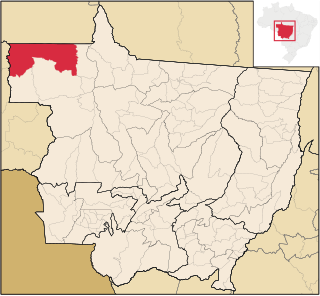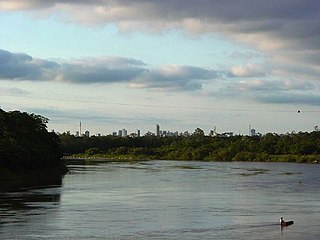
The Juruena River is a 1,240 km (770 mi) long river in west-central Brazil, in the state of Mato Grosso.
The Xingu Indigenous Park is an indigenous territory of Brazil, first created in 1961 as a national park in the state of Mato Grosso, Brazil. Its official purposes are to protect the environment and the several tribes of Xingu indigenous peoples in the area.
The Trumai are an indigenous people of Brazil. They currently reside within the Xingu Indigenous Park, in the state of Mato Grosso. They have a population of 258 in 2014. They were 97 in 2011 and 120 in 2006, up from a low of 26 in 1966.
The Yudjá or Juruna are an Indigenous people of Brazil. They were formerly the major tribe along the Xingu River, but are now divided into two groups, a westernized northern group near Altamira, Para near the big bend of the Xingu and a more conservative group in the Xingu Indigenous Park at the headwaters of the Xingu in Mato Grosso. The southern group lives in two villages located near the mouth of the Maritsauá-Mitau River. They fish and raise crops, such as manioc.

Colniza is a municipality in the state of Mato Grosso, Brazil.
The Matipu people are an indigenous people of Brazil. They live in the southern part of the Xingu Indigenous Park in the state of Mato Grosso. Their a population is estimated at about 149 individuals in 2011, up from population of 40 in the 1995 census. They are mainly of animist faith and share many cultural traits with other Xingu peoples.

The Cuiabá River is a Brazilian river in the western state of Mato Grosso that flows in the Río de la Plata Basin. It is a tributary of the São Lourenço River.

Aripuanã River is a river in the Mato Grosso and Amazonas states in north-western Brazil. It is a tributary of the Madeira River in the Amazon Basin. The town of Novo Aripuanã is located on its banks where it merges into the Madeira River. The town of Aripuanã is also on its banks, but on the upper (southern) section of the river.
Madeirinha River is a river of Mato Grosso and Amazonas states in north-western Brazil, a left tributary of the Roosevelt River.
The Culuene River, or Kuluene River is a 600 km tributary of Xingu River in Mato Grosso, a state in western Brazil. The main economic activities in the region are agriculture and cattle farming.
The Curisevo River is a river of Mato Grosso state in western Brazil. It flows through the Xingu Indigenous Park.
The Ferro River is a river of Mato Grosso state in western Brazil. It flows northeast, receives the Steinen River from the south, enters the Xingu Indigenous Park, receives the combined Ronuro and Jatoba rivers from the south and joins the Xingu River which flows north into the Amazon.

Santa Cruz do Xingu is a municipality in the state of Mato Grosso in the Central-West Region of Brazil.

Nova Ubiratã is a municipality in the state of Mato Grosso in the Central-West Region of Brazil.
The Ikpeng are an indigenous community that now lives in the Xingu Indigenous Park in Mato Grosso, Brazil. They had a population of 459 in 2010, up from a low of 50 in 1969.
Rio Ronuro Ecological Station is an ecological station in the state of Mato Grosso, Brazil. It protects an area of contact between Amazon rainforest in the north and Cerrado semi-deciduous forest in the south. Since being created in 1998 it has been reduced in size and has suffered from significant deforestation.
The Casca River is a river of the state of Mato Grosso, Brazil. It is a tributary of the Roncador River.
The Culuene Biological Reserve is a biological reserve in the state of Mato Grosso, Brazil. It protects an area of cerrado forest in contact with seasonal deciduous forest on the left (west) bank of the Culuene River.






